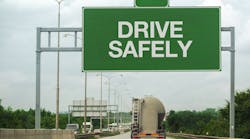Wow, time flies. I may be dating myself, but I remember when, 15 years ago, the Federal Motor Carrier Safety Administration briefed the industry by holding a massive stakeholder meeting to educate us all on a new tool that would effectively replace Safestat as FMCSA's preeminent safety measurement system. To younger safety people, yes, there once was a program called Safestat, which never seemed to provide the most precise picture of a carrier’s safety performance and didn’t provide the accuracy the trucking industry and FMCSA needed. So, in 2008, enter Compliance, Safety, Accountability, referred to these days simply as CSA.
Jump to today, when FMCSA is trying to eliminate all roadway fatalities. The agency recently proposed updates to its Safety Measurement System (SMS) to better use its data to make roads safer. As a result, along comes a new CSA—CSA 2.0—one that the industry had long worried would incorporate Item Response Theory (IRT) into its algorithm, a model that was difficult at best to describe … and I won’t even try here.
See also: FMCSA proposes long-awaited changes to CSA, eliminates IRT
Introduced to the industry in February, FMCSA solicited industry comment on how it would affect their safety measurements. CSA 2.0, thankfully, abandons IRT, as I suspect that incorporating this model proved to be more difficult than it was to explain. The newest proposal seeks comments from the industry on the changes that remain in CSA 2.0 and whether they are beneficial in pinpointing safety problems that could exist within a carrier’s operations.
The remaining changes lay out rather simply. Gone is BASICS, replaced by more accurate “safety categories,” which makes sense considering that BASICs scores were more often than not safety categories all along—and that’s how I explained them to the uninitiated outside our industry. FMCSA has made changes to those safety categories, merging drug-and-alcohol violations into the Unsafe Driving category and recognizing how big vehicle maintenance is by dividing it into two categories, including one, Driver Observed, that would be used most during a pre- and post-trip inspections.
One of the more drastic changes involves severity weights. Gone are the previous and too-numerous 1 through 10 measures, replaced by simpler 1s or 2s. This is an opportunity to better understand severity weights and remove any subjectivity that may have played a part in them. Under CSA 2.0, out-of-service violations and disqualifying unsafe driving events would be 2s; everything else would qualify as 1s. These new severity weights are less cumbersome and as easy to understand as they might be difficult for drivers and fleets to overcome. As FMCSA claims on its preview website, they are straightforward—and I must agree.
See also: Let’s win safety, by any and all means
Change for the sake of change can be good or it can be bad, but FMCSA always planned for CSA to evolve. When it was rolled out 15 years ago, FMCSA admitted CSA was a work in progress and that the industry would have a role in changing it—a good example being electronic logging devices. ELDs have had a huge effect on the Hours of Service BASIC or safety category. CSA 2.0 would be no different, knowing that an ever-evolving industry demands changes and adaptations.
However, change, without incorporating the correct changes, may not be all it’s cracked up to be. Questions remain—importantly contained within the industry comments on CSA 2.0—that FMCSA needs to acknowledge, just as the agency’s preview website helps the industry know the parameters of the proposed new system. Be confident that FMCSA will review each comment before CSA 2.0 is finalized. History shows that safety scoring always is evolving. Technology continues to play a pivotal role in our industry’s freight delivery model, and this scoring system must reflect that. Trucking should never object to our safety performance being measured. We should, in turn, insist that it be measured correctly.
David Heller is the senior vice president of safety and government affairs at the Truckload Carriers Association. Heller has worked for TCA since 2005, initially as director of safety, and most recently as the VP of government affairs.




